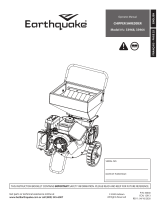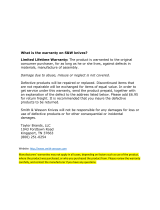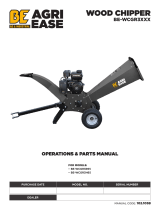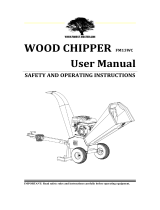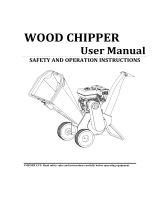
Operator’s Manual
Chipper Shredders
8 Check for parts online at www.getearthquake.com or call 800-345-6007 M-F 8-5
• Never attempt to reposition or move the chipper
shredder unit while it is running. Doing so could cause
the machine to tip over, and reaching to steady the unit
could result in accidental insertion of your hands into
the chipper cone or shredder hopper areas.
• Never continue to operate the machine if it starts
making unusual noise or vibration. Shut the engine o
immediately, allow the rotor to stop, disconnect the
spark plug wire and secure the wire away from the spark
plug. Inspect the unit for any signs of damage or foreign
material in the chipping or shredding areas. Remove
any solid material that may be preventing the unit from
operating properly.
• Never attempt to clear clogs from the chipper cone,
shredder hopper or discharge chute while the unit is
running. Always shut the engine o, allow the rotor
to come to a complete stop, and remove the spark
plug wire from the spark plug before removing excess
materials.
• Never attempt to perform any maintenance, repairs,
or attachment of accessories while the unit is running.
Always shut the unit o, allow the rotor to come to a
complete stop, and remove the spark plug wire from the
spark plug before beginning these activities.
• Always make sure that the shredding chamber, shredder
hopper, and chipper cone are empty before starting
the unit after it has been idle. Attempting to start the
unit with material in these areas could cause the engine
starting cord to stop suddenly, injuring your hand and
ngers, or toppling the unit over. Vibration is generally a
warning sign of trouble.
• Use only attachments and accessories approved of by
the manufacturer of the machine.
• Make sure chipper shredder is free of debris before
starting the engine.
• Never attempt to make any adjustments while the
engine is running.
• After striking a forgein object, stop the engine (motor),
remove spark plug wire, and wait for all moving parts
to come to a complete stop. Thorougly inspect the
machine for any damage, repair the damage before
restarting and operating the machine.
• Use only attachments and accessories approved by the
manufacturer of the machine.
ENGINE SPECIFIC SAFETY
• Before cleaning, repairing, or inspecting, shut o the
engine and make certain that all moving parts have
come to a complete stop. Disconnect the spark plug
wire and secure the wire away from the spark plug to
prevent accidental starting.
Preventing Carbon Monoxide Poisoning
• Always start and run engine outdoors. Do not start or run
engine in an enclosed area, even if doors or windows are open.
• Never try to ventilate engine exhaust indoors. Carbon
monoxide can reach dangerous levels very quickly.
• Never run engine outdoors where exhaust fumes may be
pulled into a building.
• Never run engine outdoors in a poorly ventilated area where
the exhaust fumes may be trapped and not easily taken
away. (Examples include: in a large hole or areas where hills
surround your working area.)
• Never run engine in an enclosed or partially enclosed area.
(Examples include: buildings that are enclosed on one or
more sides, under tents, car ports or basements.)
• Always run the engine with the exhaust and muer pointed
in the direction away from the operator.
• Never point the exhaust muer towards anyone. People
should always be many feet away from the operation of the
engine and its attachments.
• Do not change the engine governor settings or over-speed
the engine.
• Do not operate the engine in a confined space where
dangerous carbon monoxide fumes can collect.
WARNING
Engines give o carbon monoxide, an odorless, colorless,
poison gas. Carbon monoxide may be present even if you
do not smell or see any engine exhaust. Breathing carbon
monoxide can cause nausea, fainting or death, in addition
to drowsiness, dizziness and confusion. If you experience
any of these symptoms, seek fresh air and medical attention
immediately.
If your machine comes with a separate engine manual, be
sure to read and follow all safety and warning precautions
outlined there, in addition to any in this manual.
• Handle fuel with care; it is highly ammable.
a. Use an approved fuel container.
b. Never add fuel to a running engine or hot engine.
c. Fill fuel tank outdoors with extreme care. Never ll
fuel tank indoors.
d. Replace gasoline cap securely and clean up spilled
fuel before restarting.























